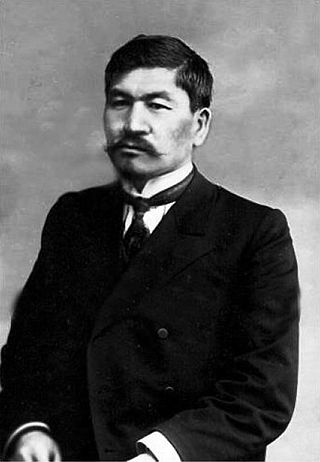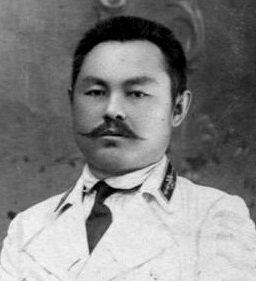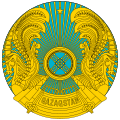
Kazakhstan, the largest country fully within the Eurasian Steppe, has been a historical crossroads and home to numerous different peoples, states and empires throughout history. Throughout history, peoples on the territory of modern Kazakhstan had nomadic lifestyle, which developed and influenced Kazakh culture.

The national flag of Kazakhstan, also called the Kazakh flag, was adopted on 4 June 1992, replacing the flag of the Kazakh Soviet Socialist Republic. The flag was designed by Shaken Niyazbekov.

Semey ), until 2007 known as Semipalatinsk and between 1917 and 1920 as Alash-Qala, is a city in eastern Kazakhstan, in the Kazakh part of Siberia. When Abai Region was created in 2022, Semey became its administrative centre. It lies along the Irtysh River near the border with Russia, 1,000 kilometers (620 mi) north of Almaty and 700 kilometers (430 mi) southeast of the Russian city of Omsk. Its population is 350,967.

The Turkestan Autonomous Soviet Socialist Republic, originally called the Turkestan Socialist Federative Republic, was an autonomous republic of the Russian Soviet Federative Socialist Republic located in Soviet Central Asia. Uzbeks were the preeminent nation of the Turkestan ASSR. Tashkent was the capital and largest city in the region.

The Kazakh Autonomous Socialist Soviet Republic, abbreviated as Kazak ASSR and simply Kazakhstan, was an autonomous republic of the Russian Soviet Federative Socialist Republic (RSFSR) within the Soviet Union which existed from 1920 until 1936.

National delimitation in the Union of Soviet Socialist Republics was the process of specifying well-defined national territorial units from the ethnic diversity of the Union of Soviet Socialist Republics (USSR) and its subregions.

Soviet Central Asia was the part of Central Asia administered by the Soviet Union between 1918 and 1991, when the Central Asian republics declared independence. It is nearly synonymous with Russian Turkestan in the Russian Empire. Soviet Central Asia went through many territorial divisions before the current borders were created in the 1920s and 1930s.

Alikhan Nurmukhameduly Bukeikhanov was a Kazakh politician and publisher who served as the Chairman of the Provisional National Government of Alash Orda and one of the leaders of the Alash party from late 1917 to 1920.

Mirjaqyp Dulatuly (Kazakh: Міржақып Дулатұлы, Mırjaqyp Dulatūly; Russian: Миржакып Дулатов, also known as Mir Yakub Dulatov, was a Kazakh poet, writer and one of leaders of Kazakh nationalist Alash Orda government. He also is known to have used the pen names Madiyar and Arghyn.
Pro-independence movements in the Russian Civil War within the territory of the former Russian Empire sought the creation of independent nation states that were not aligned with the Bolsheviks after the October Revolution. Many pro-independence movements emerged after the dissolution of the Russian Empire and fought in the Russian Civil War.

Alash was a political party and liberation movement in the Russian Republic and Soviet Russia, and the ruling party of Alash Autonomy on the territory of present-day Kazakhstan and Russia. They advocated for equal treatment between Kazakhs and Russians and the cessation of Russian settlement on the Kazakh lands. It was notably the first modern organized political Kazakh and Kyrgyz elite group.

Magzhan Zhumabayev, was a Kazakh poet and writer who revolutionized the Kazakh language.

The Syr-Darya Oblast was one of the oblasts of the Russian Empire, a part of Russian Turkestan. Its center was Tashkent.
Alat were one salient Turkic tribe known from Chinese annals.

The Semirechyenskaya Oblast was an oblast (province) of the Russian Empire. It corresponded approximately to most of present-day southeastern Kazakhstan and northeastern Kyrgyzstan. It was created out of the territories of the northern part of the Khanate of Kokand that had been part of the Kazakh Khanate. The name "Semirechye" itself is the direct Russian translation of the historical region of Jetysu. Its site of government was Verniy.

The Kazakhstan–Russia border is the 7,644-kilometre (4,750 mi) international border between the Republic of Kazakhstan and the Russian Federation. It is the longest continuous international border in the world and the second longest by total length, after the Canada–United States border. It is in the same location as the former administrative-territorial border between the Kazakh Soviet Socialist Republic and the Russian Soviet Federative Socialist Republic.

Muhammedjan Tynyshpaev was a Kazakh engineer, activist, and intellectual. He surveyed and engineered the railways of Russian Central Asia, while also active in the young political newspapers of the region. Through his work, he became known as a political activist, ethnographer, and historian.

The Turkestan Autonomy or Kokand Autonomy was a short-lived state in Central Asia that existed at the beginning of the Russian Civil War. It was formed on 27 November 1917 and existed until 22 February 1918. It was a secular republic, headed by a president.
Üsh Zhüz was a Kazakh socialist political party. Founded in the wake of the Central Asian revolt of 1916 and the Russian Revolution of 1917, the party supported Pan-Turkism, federal republicanism and land reform. It was opposed to the Alash party, which aligned with the White movement, while Üsh Zhüz itself aligned with the Bolsheviks and eventually merged into the Communist Party of Turkestan. Some of its leading members, including Turar Ryskulov, became prominent figures within the Turkestan Autonomous Soviet Socialist Republic (TASSR).


















